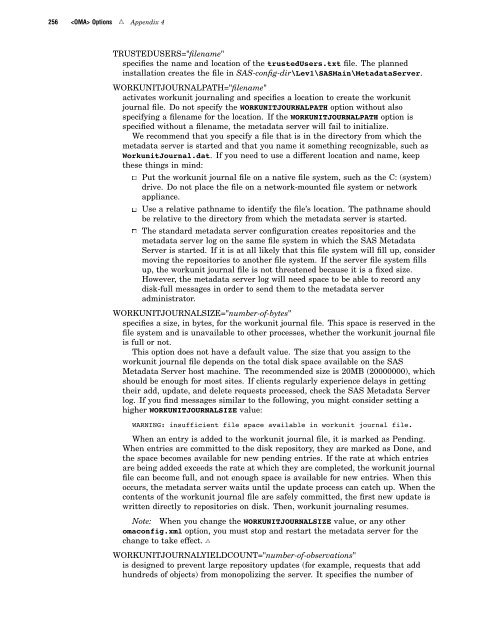SAS 9.1.3 Intelligence Platform: System Administration Guide
SAS 9.1.3 Intelligence Platform: System Administration Guide
SAS 9.1.3 Intelligence Platform: System Administration Guide
Create successful ePaper yourself
Turn your PDF publications into a flip-book with our unique Google optimized e-Paper software.
256 Options R Appendix 4<br />
TRUSTEDUSERS="filename"<br />
specifies the name and location of the trustedUsers.txt file. The planned<br />
installation creates the file in <strong>SAS</strong>-config-dir\Lev1\<strong>SAS</strong>Main\MetadataServer.<br />
WORKUNITJOURNALPATH="filename"<br />
activates workunit journaling and specifies a location to create the workunit<br />
journal file. Do not specify the WORKUNITJOURNALPATH option without also<br />
specifying a filename for the location. If the WORKUNITJOURNALPATH option is<br />
specified without a filename, the metadata server will fail to initialize.<br />
We recommend that you specify a file that is in the directory from which the<br />
metadata server is started and that you name it something recognizable, such as<br />
WorkunitJournal.dat. If you need to use a different location and name, keep<br />
these things in mind:<br />
3 Put the workunit journal file on a native file system, such as the C: (system)<br />
drive. Do not place the file on a network-mounted file system or network<br />
appliance.<br />
3 Use a relative pathname to identify the file’s location. The pathname should<br />
be relative to the directory from which the metadata server is started.<br />
3 The standard metadata server configuration creates repositories and the<br />
metadata server log on the same file system in which the <strong>SAS</strong> Metadata<br />
Server is started. If it is at all likely that this file system will fill up, consider<br />
moving the repositories to another file system. If the server file system fills<br />
up, the workunit journal file is not threatened because it is a fixed size.<br />
However, the metadata server log will need space to be able to record any<br />
disk-full messages in order to send them to the metadata server<br />
administrator.<br />
WORKUNITJOURNALSIZE="number-of-bytes"<br />
specifies a size, in bytes, for the workunit journal file. This space is reserved in the<br />
file system and is unavailable to other processes, whether the workunit journal file<br />
is full or not.<br />
This option does not have a default value. The size that you assign to the<br />
workunit journal file depends on the total disk space available on the <strong>SAS</strong><br />
Metadata Server host machine. The recommended size is 20MB (20000000), which<br />
should be enough for most sites. If clients regularly experience delays in getting<br />
their add, update, and delete requests processed, check the <strong>SAS</strong> Metadata Server<br />
log. If you find messages similar to the following, you might consider setting a<br />
higher WORKUNITJOURNALSIZE value:<br />
WARNING: insufficient file space available in workunit journal file.<br />
When an entry is added to the workunit journal file, it is marked as Pending.<br />
When entries are committed to the disk repository, they are marked as Done, and<br />
the space becomes available for new pending entries. If the rate at which entries<br />
are being added exceeds the rate at which they are completed, the workunit journal<br />
file can become full, and not enough space is available for new entries. When this<br />
occurs, the metadata server waits until the update process can catch up. When the<br />
contents of the workunit journal file are safely committed, the first new update is<br />
written directly to repositories on disk. Then, workunit journaling resumes.<br />
Note: When you change the WORKUNITJOURNALSIZE value, or any other<br />
omaconfig.xml option, you must stop and restart the metadata server for the<br />
change to take effect. R<br />
WORKUNITJOURNALYIELDCOUNT="number-of-observations"<br />
is designed to prevent large repository updates (for example, requests that add<br />
hundreds of objects) from monopolizing the server. It specifies the number of
















